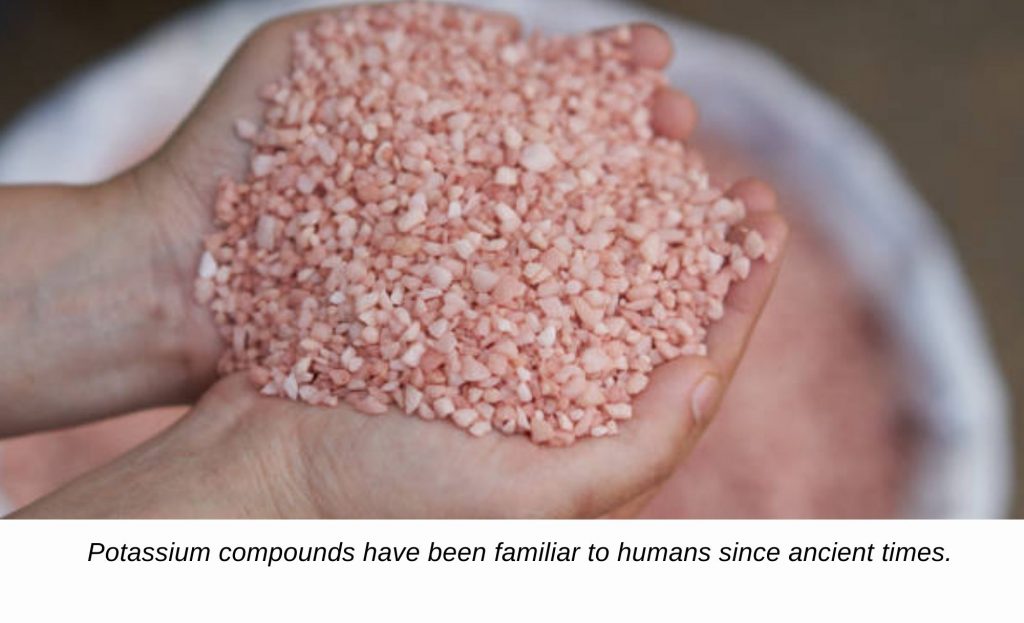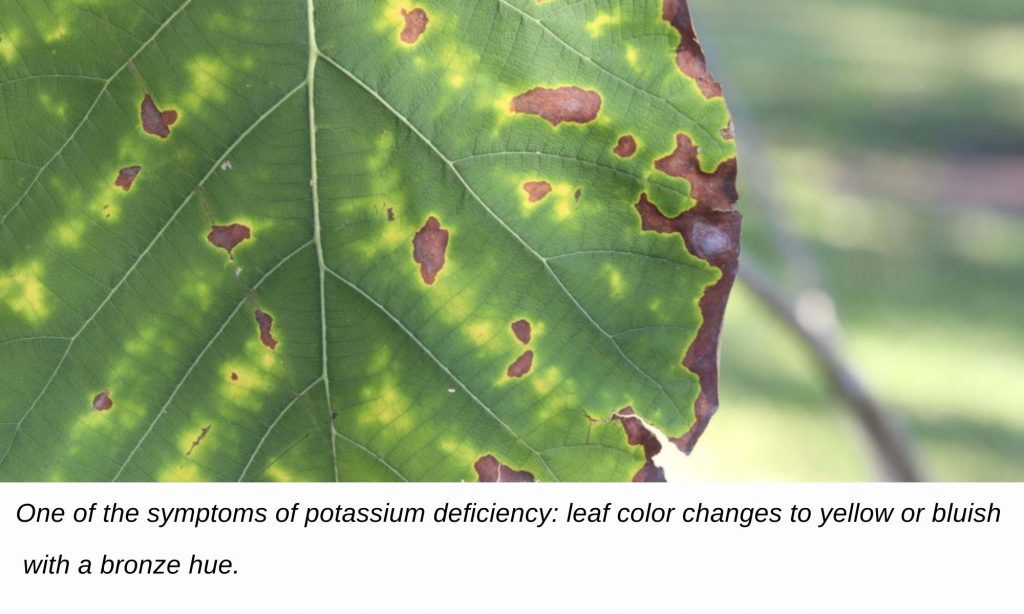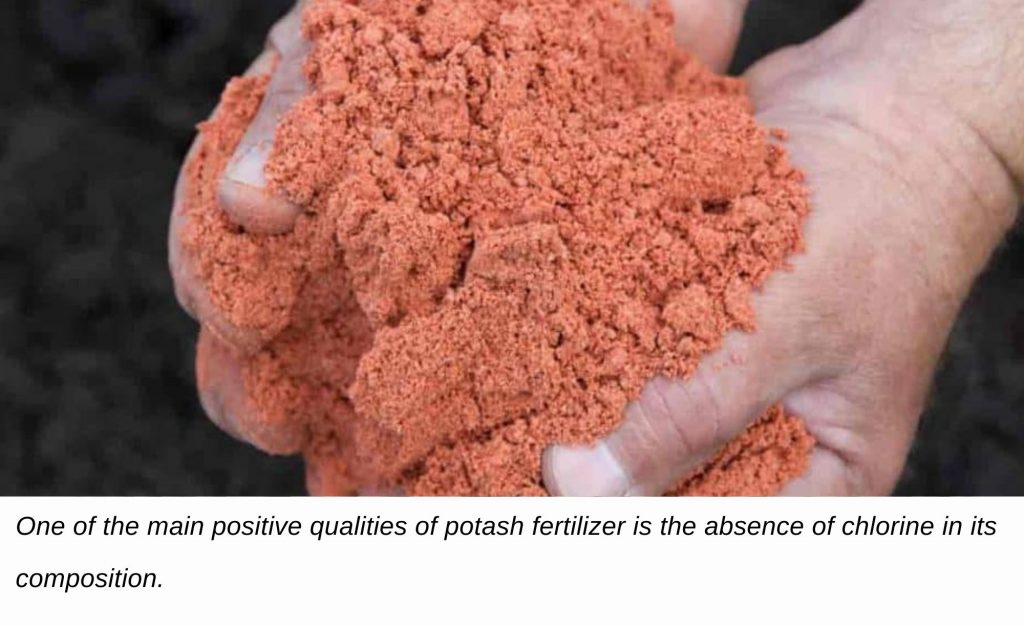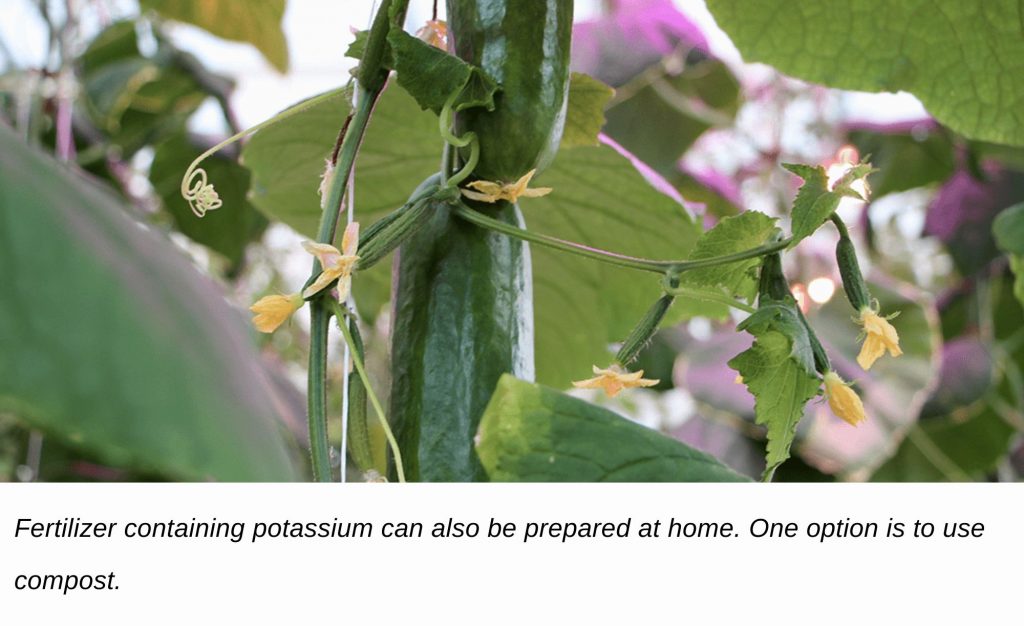Growing in soil with a full range of nutrients, plants will enjoy active growth and high yields. The deficiency of macro and micronutrients necessary for cultivated plants leads to slow development and low fructification.
Among the elements that should be received by plants in sufficient quantities is potassium. Its lack is highly detrimental to the plants’ health.
Potassium in nature
Potassium is an alkaline metal that is quite widespread on Earth. Potassium compounds have been familiar to humans since ancient times. They are quite common in nature but the element can’t be found in its pure form. The reason for that is its high chemical activity.
So where can potassium be found in nature?
- First of all, it’s found in fairly large quantities in the Earth’s crust. Its content is estimated at about 2.4%. The element is an important component of soil and rocks.
- Secondly, large deposits of potassium salts have been recorded at the sites of evaporation of ancient seas.
- The waters of the ocean also contain a significant amount of this element. There, the concentration of potassium is about 0.06%.
Potassium content in the soil
The macronutrient isn’t found in all soils in sufficient quantities. Heavy soils are most rich in this element. In clay soils and loams its amount is usually equal to 3%. Potassium deficiency is characteristic for light soils where its amount reaches up to 0.05%. Plants especially suffer from the shortage of potassium in peat soils.

The nutrient can be found in the top layer of soil, but plants can assimilate only 10% of the substance. The remaining amount is contained in slightly soluble compounds. So in order to get high yields, potassium fertilization is necessary. The fertilizers are extremely important for increasing the productivity of agricultural plots. All types are available in a water-soluble form and are well assimilated by plants.
The role of potassium in plant culture
Potassium is one of the main essential elements of mineral nutrition along with nitrogen and phosphorus. Unlike nitrogen and phosphorus, it’s not a part of organic compounds in plants but is in the plant cells in ionic form as soluble salts in the cell sap and partially as fragile adsorption complexes with cytoplasm colloids.
The element is much more abundant in young vital parts and organs of plants than in old ones. A lack of potassium in nutrient medium results in its outflow from older organs and tissues to young growing organs, where it’s reused (reutilized).
The physiological functions of the micronutrient in the plant organism are diverse. It has a positive effect on the physical state of cytoplasm colloids, increases their water content, swellability, and viscosity, which is important for normal metabolism in cells, as well as for increasing plant resistance to drought. With a lack of potassium and increased transpiration, plants lose turgor and wilt faster.
Potassium has a positive effect on the intensity of photosynthesis, oxidative processes, and formation of organic acids in plants, and it participates in carbohydrate and nitrogen metabolism. If a plant lacks potassium, protein synthesis is inhibited, and as a result, all nitrogen metabolism is disrupted.

The nutrient increases the activity of enzymes involved in carbohydrate metabolism, in particular sugar and amylase. This explains the positive effect of potassium fertilizers on the accumulation of starch in potato tubers and sugar in sugar beets and other root crops. Under the influence of the macronutrient, the frost resistance of plants increases, which is associated with a high content of sugars and an increase in osmotic pressure in the cells.
With a sufficient amount of the element, nutrition increases the resistance of plants to various diseases. Potassium promotes the development of mechanical elements, vascular bundles, and bast fibers, so it positively affects the strength of stems and plant resistance to lodging.
Signs of potassium deficiency and excess
If a plant lacks potassium, ammonia begins to accumulate in its cells. This leads to resistance to fungal diseases and the death of shoots. In fact, the formation of protein and the synthesis of complex carbohydrates stops in the cells of the plant.
However, an excess of potassium also has a negative effect on plant development. Therefore, unlike with phosphate fertilizers, you need to be careful with potassium fertilizers and not exceed the dosage.
In general, potassium deficiency manifests itself in the following ways:
- Impaired formation of buds;
- Decrease in the number of fruits and their size;
- Leaf color changes to yellow or bluish with a bronze hue;
- Leaf tips and edges die off;
- Stems get thinner;
- Plants become sickly and get attacked by pests more often;
- Plants’ resistance to drought and frost decreases;
- Germination of seeds collected from such plants decreases.
Signs of the nutrient excess might include:
- Flowering slows down or stops altogether;
- New leaves become smaller, darker in color;
- The tops and edges of leaves become rusty, faded;
- Active growth of lateral shoots;
- Lower leaves grow dull and develop chlorotic spots;
- The stems weaken, become thin and brittle.
Potassium fertilizers
Potassium fertilizers are mineral substances that provide a source of the element for plant nutrition. In addition to increasing yields, sufficient levels of the macronutrient ensure the resistance of plants to cold and disease, increase the amount of sugar and vitamins in fruits, improve storage, and prolong the flowering of ornamental plants.
What are potassium fertilizers for?
Due to the variety of nutrient mixtures, potassium fertilizers can be used in spring and fall. One of their distinctive features is good water solubility so that the components are quickly absorbed by plants and enter into metabolic processes. Crops react to the macronutrient levels differently but proper fertilization has the same effect on these properties of plants:
- drought tolerance and resistance to adverse conditions;
- frost-resistance;
- photosynthesis activation;
- accumulation of sugar and starch;
- reduced susceptibility to diseases;
- improved marketable and palatable qualities of fruits.
Potassium fertilizers are in high demand and can be used for the following types of soil:
- podzolic;
- peat;
- limestone;
- sandy.
Some plants can’t actively develop without potassium fertilization. Grapes, potatoes, beets, cucumbers, and tomatoes have an increased need for the nutrient.
It is important to remember that potassium fertilizer won’t be effective if there is no nitrogen and phosphorus in the soil.
Composition
These fertilizers include natural elements that are difficult to find in other types of fertilizer. They affect the formation of immunity, so the plant easily tolerates all diseases. These mineral elements are:
- sylvinite;
- schoenite;
- alunite;
- kainite;
- polyhalite;
- langbeinite;
- sylvinite;
- carnallite.
Use and storage
Remember that potassium fertilizers must be applied as soon as possible because they begin to lose their properties as soon as they start interacting with air and moisture. The place of storage should be dry as the fertilizer will harden in humid environments.
When working with potassium fertilizers, be sure to wear a specialized suit. During application, consider the rates to ensure the safety of your crops.
Types of potassium fertilizers
Mineral fertilizers containing potassium come in a variety of forms. Based on the raw material used, there are such types as:
Potassium chloride
The most common fertilizer type. Can be recognized by its pink-colored crystals. Because of their ability to absorb water, the crystals tend to cake if not stored properly. Due to the fact that potassium chloride contains 40% chlorine, this fertilizer isn’t recommended for use with chlorophobic crops (potatoes, cucumbers, tomatoes, beans, house plants). But celery and spinach respond well to the use of the compound.
This type of fertilizer shouldn’t be used on heavy soils, where it will contribute to the accumulation of salt and increase acidity. For the chlorine to wash out/evaporate from the soil faster, it’s better to apply the fertilizer in autumn.
Potassium salt
The fertilizer is made by mixing potassium chloride with fine sylvinite or kainite. The macronutrient content of this mixture is 40% and the chlorine is even higher than in the previous type. This is why this fertilizer isn’t suitable for use on chlorine-intolerant plants.
It’s applied in the fall, by embedding it deep into the soil. The compound can also be applied in the spring, but only on soils saturated with moisture: under these conditions, the chlorine gets washed out and the potassium is fixed in the soil. It’s not recommended to use it in summer, though.
Potassium sulfate
Comes in the form of small gray crystals, well soluble in water. In contrast to potassium chloride, it doesn’t absorb moisture and doesn’t cake.
Because there’s no chlorine in this compound, it’s favorably accepted by plants that usually negatively respond to this element. In addition to sulfur and potassium, the additive contains calcium and magnesium, so its usefulness for plants is even higher. This compound is particularly well accepted by vegetables, which are better preserved due to the necessary intake of sulfur.

Universal potassium sulfate can be used at any time of the year on almost any soil, except for acidic soils: in this case, the application of the additive leads to an oversaturation of the soil with acid. It’s also important to know that this type of fertilizer and lime mineral additives shouldn’t be used together.
Potassium magnesia (potassium magnesium sulfate)
This fertilizer has low hygroscopicity and good dispersibility. The compound also doesn’t contain chlorine, so it can be successfully used for fertilizing vegetables (potatoes, tomatoes, etc.).
Since sandy and sandy loam soils have a special need for potassium and magnesium, it’s recommended to treat them with this type of fertilizer.
Potassium nitrate
Due to the nitrogen in its composition, this type of fertilizer is a complex growth stimulant for plants. Because of its high moisture absorption, the compound should be stored in a dry place.
The fertilizer is only suitable for use in neutral soils (alkaline soils can’t absorb potassium and acidic soils can’t absorb nitrogen). As a rule, it’s used in the spring and can also be used in summer.
Potassium carbonate (potash)
One of the main positive qualities of this fertilizer is the absence of chlorine in its composition. Other advantages of this compound include the possibility of fertilizing acidic soils.
But because of its increased ability to absorb moisture, this compound dries up quickly, making it unsuitable for use. To improve its physical properties, it’s sometimes mixed with lime or peat.
The choice of the type of fertilizer depends on the specific type of plant that needs feeding. Provided you use the right dose and apply the fertilizer at the right time, it will be at the maximum of its effectiveness.
Potassium fertilizer application
Potassium fertilizers of different kinds can be used to fertilize the garden or a vegetable patch. It’s important to consider the period of application.
1. Chloric compounds. Fertilizers containing chlorine are rapidly soluble in water. These compounds are applied in the fall, allowing enough time for the chlorine to dissipate.
2. Sulfuric compounds. These fertilizers are also characterized by fast solubility in water. Application of this type of potassium fertilizer is carried out mostly in autumn. In small quantities, they can also be used in spring.
Potassium fertilizers mentioned above are applied at different times of the year. They’re often used directly during sowing or planting spring. Also, if chlorine or phosphorus-potassium fertilizer is necessary, fall is the best time to apply it.

These compounds can also be used in winter in greenhouses. There’s a number of ways to apply potassium-containing fertilizers:
1. Main fertilization. Fertilizing compounds are applied to the soil before digging or plowing in autumn. This promotes the penetration of potassium and other minerals deep into the soil, which facilitates their absorption from the soil by the root systems of plants.
2. Presowing. A small amount of fertilizer is applied directly into the holes prepared for planting. In this case, the substances will be dissolved in water, creating an optimal nutrient environment for crops.
3. Additional fertilizing. It’s carried out when there are signs of mineral deficiency in plants. Also, potash compounds can be applied to the soil before flowering and fruiting.
In case of potassium deficiency, fertilizers should be applied gradually, a little at a time. Dosed feeding allows plants to gradually absorb nutrients without accumulating an excess. It’s recommended to switch between different fertilizers, using dry and liquid forms alternately. In a rainy summer, it’s better to use powder forms and in dry periods, liquid composition. Standard rates per 10 square feet are:
- 0.7 – 1.4 oz. potassium chloride;
- 0.3 – 0.5 oz. potassium sulfate;
- 0.7 oz. potassium nitrate.
Use limitations
When planning to apply fertilizers, it’s important to follow the instructions for use of a particular compound, because every type has its own characteristics and limitations. Let’s consider the main ones:
- Potassium sulfate is used on alkaline and neutral soils. It can’t be combined with ammonium sulfate, urea, potassium carbonate, ammonium nitrate, chalk, lime, and dolomite flour;
- Potassium magnesia can’t be mixed with potassium carbonate and urea;
- Potassium nitrate is used only on neutral soil. If mixed with manure, it can ignite. Don’t mix with potassium carbonate or ammonium sulfate;
- Potassium chloride can’t be mixed with dolomite flour, chalk, or potassium carbonate. The main disadvantage is the presence of chlorine in the composition, which limits the scope of its application.
Can you make potassium fertilizer at home?
Fertilizer containing this important macronutrient can also be prepared at home. One option is to use compost. The compost pile is placed in layers and the components used are manure or poultry droppings, grass clippings, tree bark, twigs, and dry leaves. Aerobic microorganisms, which are in the soil, process plant residues, turning them into nutrients. The only disadvantage is the long time it takes to make compost. Biopreparations for compost can be used to speed up the result.
Which potassium fertilizer is the best?
Out of all fertilizers containing this nutrient, potassium sulfate has the widest range of positive characteristics. The composition is rich in potassium, sulfur, magnesium, and calcium, which is beneficial for plants. This kind of fertilizer can be used at any time of the season and for all soils. It’s a fairly good option for fertilizing a wide range of plants, including those intolerant to chlorine, such as potatoes, tomatoes, peppers, peas, all berries, and indoor plants.
Also, when choosing a fertilizer, you can pay attention to complex compositions that contain phosphorus and nitrogen salts.
What other potassium sources are there?
The essential macronutrient can also be found in cement dust and wood ash. Cement dust is used as fertilizer for chlorine-intolerant plants; it deoxidizes the soil well and is water-soluble.
Wood ash can also be used as a quick way to fertilize plants. This kind of fertilizer contains large amounts of calcium, especially hardwood ash. Ash quickly penetrates into the soil, has a long-lasting effect and all elements are in a form accessible to plants. The downside is the absolute lack of nitrogen.
Conclusion
Potassium fertilizers should be used for growing all kinds of plants because their ability to resist adverse weather conditions largely depends on the amount of this nutrient in the soil. This kind of fertilizer also helps increase the number of harvested crops and storage time.
To ensure the active absorption of the macronutrient, apply it in combination with nitrogen and phosphorus.


